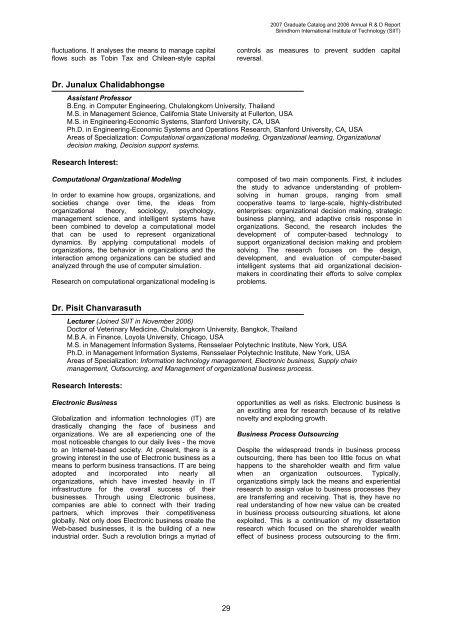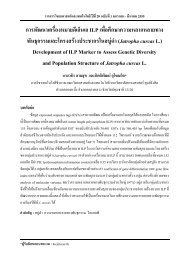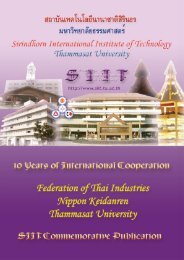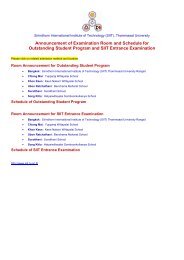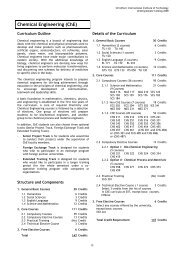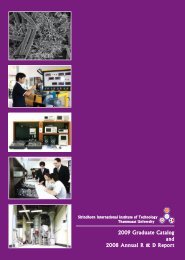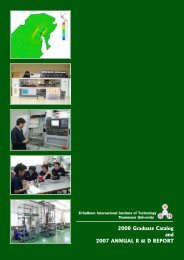2007 Graduate Catalog and 2006 Annual R & D Report - Sirindhorn ...
2007 Graduate Catalog and 2006 Annual R & D Report - Sirindhorn ...
2007 Graduate Catalog and 2006 Annual R & D Report - Sirindhorn ...
Create successful ePaper yourself
Turn your PDF publications into a flip-book with our unique Google optimized e-Paper software.
<strong>2007</strong> <strong>Graduate</strong> <strong>Catalog</strong> <strong>and</strong> <strong>2006</strong> <strong>Annual</strong> R & D <strong>Report</strong><br />
<strong>Sirindhorn</strong> International Institute of Technology (SIIT)<br />
fluctuations. It analyses the means to manage capital<br />
flows such as Tobin Tax <strong>and</strong> Chilean-style capital<br />
controls as measures to prevent sudden capital<br />
reversal.<br />
Dr. Junalux Chalidabhongse<br />
Assistant Professor<br />
B.Eng. in Computer Engineering, Chulalongkorn University, Thail<strong>and</strong><br />
M.S. in Management Science, California State University at Fullerton, USA<br />
M.S. in Engineering-Economic Systems, Stanford University, CA, USA<br />
Ph.D. in Engineering-Economic Systems <strong>and</strong> Operations Research, Stanford University, CA, USA<br />
Areas of Specialization: Computational organizational modeling, Organizational learning, Organizational<br />
decision making, Decision support systems.<br />
Research Interest:<br />
Computational Organizational Modeling<br />
In order to examine how groups, organizations, <strong>and</strong><br />
societies change over time, the ideas from<br />
organizational theory, sociology, psychology,<br />
management science, <strong>and</strong> intelligent systems have<br />
been combined to develop a computational model<br />
that can be used to represent organizational<br />
dynamics. By applying computational models of<br />
organizations, the behavior in organizations <strong>and</strong> the<br />
interaction among organizations can be studied <strong>and</strong><br />
analyzed through the use of computer simulation.<br />
Research on computational organizational modeling is<br />
composed of two main components. First, it includes<br />
the study to advance underst<strong>and</strong>ing of problemsolving<br />
in human groups, ranging from small<br />
cooperative teams to large-scale, highly-distributed<br />
enterprises: organizational decision making, strategic<br />
business planning, <strong>and</strong> adaptive crisis response in<br />
organizations. Second, the research includes the<br />
development of computer-based technology to<br />
support organizational decision making <strong>and</strong> problem<br />
solving. The research focuses on the design,<br />
development, <strong>and</strong> evaluation of computer-based<br />
intelligent systems that aid organizational decisionmakers<br />
in coordinating their efforts to solve complex<br />
problems.<br />
Dr. Pisit Chanvarasuth<br />
Lecturer (Joined SIIT in November <strong>2006</strong>)<br />
Doctor of Veterinary Medicine, Chulalongkorn University, Bangkok, Thail<strong>and</strong><br />
M.B.A. in Finance, Loyola University, Chicago, USA<br />
M.S. in Management Information Systems, Rensselaer Polytechnic Institute, New York, USA<br />
Ph.D. in Management Information Systems, Rensselaer Polytechnic Institute, New York, USA<br />
Areas of Specialization: Information technology management, Electronic business, Supply chain<br />
management, Outsourcing, <strong>and</strong> Management of organizational business process.<br />
Research Interests:<br />
Electronic Business<br />
Globalization <strong>and</strong> information technologies (IT) are<br />
drastically changing the face of business <strong>and</strong><br />
organizations. We are all experiencing one of the<br />
most noticeable changes to our daily lives - the move<br />
to an Internet-based society. At present, there is a<br />
growing interest in the use of Electronic business as a<br />
means to perform business transactions. IT are being<br />
adopted <strong>and</strong> incorporated into nearly all<br />
organizations, which have invested heavily in IT<br />
infrastructure for the overall success of their<br />
businesses. Through using Electronic business,<br />
companies are able to connect with their trading<br />
partners, which improves their competitiveness<br />
globally. Not only does Electronic business create the<br />
Web-based businesses, it is the building of a new<br />
industrial order. Such a revolution brings a myriad of<br />
opportunities as well as risks. Electronic business is<br />
an exciting area for research because of its relative<br />
novelty <strong>and</strong> exploding growth.<br />
Business Process Outsourcing<br />
Despite the widespread trends in business process<br />
outsourcing, there has been too little focus on what<br />
happens to the shareholder wealth <strong>and</strong> firm value<br />
when an organization outsources. Typically,<br />
organizations simply lack the means <strong>and</strong> experiential<br />
research to assign value to business processes they<br />
are transferring <strong>and</strong> receiving. That is, they have no<br />
real underst<strong>and</strong>ing of how new value can be created<br />
in business process outsourcing situations, let alone<br />
exploited. This is a continuation of my dissertation<br />
research which focused on the shareholder wealth<br />
effect of business process outsourcing to the firm.<br />
29


